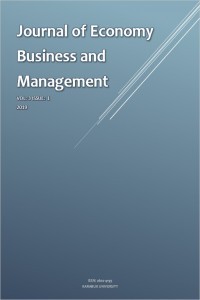The Bank Managers’ Leadership Style and Its Impact on Employees’ Job Satisfaction in Libya
Employment satisfaction is a major component of any company's success. In other words, companies with more satisfied employees are expected to be effective and efficient. This study examines the kinds of current leadership types in Libyan banks and the impact they have on employee satisfaction. The target group consisted of 400 employees from Libyan banks. A comprehensive survey of stratified workers at the Banks of Libya has been circulated with four hundred questionnaires. The respondents replied a total of 204 questionnaires (51 %). The results of the research showed a strong positive link between autocratic leadership and employee satisfaction, together with democratic leadership, while leisure leadership has a strong negative relation to employee satisfaction.
Anahtar Kelimeler:
Bank Managers, Leadership Style, Employees, Job Satisfaction
The Bank Managers’ Leadership Style and Its Impact on Employees’ Job Satisfaction in Libya
Employment satisfaction is a major component of any company's success. In other words, companies with more satisfied employees are expected to be effective and efficient. This study examines the kinds of current leadership types in Libyan banks and the impact they have on employee satisfaction. The target group consisted of 400 employees from Libyan banks. A comprehensive survey of stratified workers at the Banks of Libya has been circulated with four hundred questionnaires. The respondents replied a total of 204 questionnaires (51 %). The results of the research showed a strong positive link between autocratic leadership and employee satisfaction, together with democratic leadership, while leisure leadership has a strong negative relation to employee satisfaction.
Keywords:
Bank Managers, Leadership Style, Employees, Job Satisfaction,
___
- Baltaci, F., Kara, E., Tascan, E., & Avsalli, H. (2012). The Effects of Leadership On Job Satisfaction (Visionary Leadership, Transformational leadership, Transactional leadership). In International Journal Symposium on Sustainable Development (Vol. 1, No. 31, pp. 220-226).
- Burgoon, B., & Buller, D. Woodall (1996). Nonverbal Communication: The unspoken dialogue.
- Chen, J. C. (2004). An empirical test of leadership effectiveness and the match/mismatch in leadership style (Doctoral dissertation, Nova Southeastern University).
- Flynn, S. I. (2009). Transformational and transactional leadership. Research Starters Sociology, 1(1), 1-6.
- Kinicki, A., & Kreitner, R. (2006). Organizational behavior: Key concepts, skills & best practices. New York: McGraw-Hill/Irwin.
- Locke, E. A. (1976). The nature and causes of job satisfaction. Handbook of industrial and organizational psychology.
- McMillan, J. H., Schumacher, S., & Singh, J. (1993). Study Guide to Accompany MacMillan, Schumacher, Research in Education: A Conceptual Introduction. HarperCollins College Publishers.
- Mishra, P. K. (2013). Job satisfaction. IOSR journal of humanities and social science, 14(5), 45-54.
- Naidu, J., & Van der Walt, M. S. (2005). An exploration of the relationship between leadership styles and the implementation of transformation interventions. SA Journal of Human Resource Management, 3(2), 1-10.
- Olsson, M., & Wass, J. (2001). Leadership style and action routines: best practice manufacturing and R&D projects. International Journal of Technology Management, 22(4), 327-343.
- Loganathan, R. (2013). The influence of leadership styles on job satisfaction at a cellulose pulp mill in KwaZulu-Natal: a case study (Doctoral dissertation).
- Uhl-Bien, M., Marion, R., & McKelvey, B. (2007). Complexity leadership theory: Shifting leadership from the industrial age to the knowledge era. The leadership quarterly, 18(4), 298-318.
- ISSN: 2602-4195
- Yayın Aralığı: Yılda 2 Sayı
- Başlangıç: 2017
- Yayıncı: Karabük Üniversitesi
